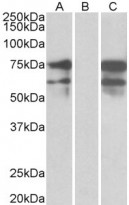ARG64263
anti-Neurexin 1 antibody
anti-Neurexin 1 antibody for Flow cytometry,Western blot and Human
Neuroscience antibody; Signaling Transduction antibody
Overview
| Product Description | Goat Polyclonal antibody recognizes Neurexin 1 |
|---|---|
| Tested Reactivity | Hu |
| Predict Reactivity | Ms, Rat, Dog |
| Tested Application | FACS, WB |
| Specificity | This antibody is expected to recognise both reported isoforms (NP_004792.1 and NP_620072.1). |
| Host | Goat |
| Clonality | Polyclonal |
| Isotype | IgG |
| Target Name | Neurexin 1 |
| Antigen Species | Human |
| Immunogen | C-KEKQPSSAKSSNKN |
| Conjugation | Un-conjugated |
| Alternate Names | Neurexin-1; PTHSL2; Neurexin-1-alpha; Neurexin I-alpha; SCZD17; Hs.22998 |
Application Instructions
| Application Suggestion |
|
||||||
|---|---|---|---|---|---|---|---|
| Application Note | WB: Recommend incubate at RT for 1h. * The dilutions indicate recommended starting dilutions and the optimal dilutions or concentrations should be determined by the scientist. |
Properties
| Form | Liquid |
|---|---|
| Purification | Purified from goat serum by antigen affinity chromatography. |
| Buffer | Tris saline (pH 7.3), 0.02% Sodium azide and 0.5% BSA. |
| Preservative | 0.02% Sodium azide |
| Stabilizer | 0.5% BSA |
| Concentration | 0.5 mg/ml |
| Storage Instruction | For continuous use, store undiluted antibody at 2-8°C for up to a week. For long-term storage, aliquot and store at -20°C or below. Storage in frost free freezers is not recommended. Avoid repeated freeze/thaw cycles. Suggest spin the vial prior to opening. The antibody solution should be gently mixed before use. |
| Note | For laboratory research only, not for drug, diagnostic or other use. |
Bioinformation
| Database Links | |
|---|---|
| Background | Neurexins function in the vertebrate nervous system as cell adhesion molecules and receptors. Two neurexin genes are among the largest known in human (NRXN1 and NRXN3). By using alternate promoters, splice sites and exons, predictions of hundreds or even thousands of distinct mRNAs have been made. Most transcripts use the upstream promoter and encode alpha-neurexin isoforms; fewer transcripts are produced from the downstream promoter and encode beta-neurexin isoforms. Alpha-neurexins contain epidermal growth factor-like (EGF-like) sequences and laminin G domains, and they interact with neurexophilins. Beta-neurexins lack EGF-like sequences and contain fewer laminin G domains than alpha-neurexins. The RefSeq Project has decided to create only a few representative transcript variants of the multitude that are possible. [provided by RefSeq, Oct 2008] |
| Research Area | Neuroscience antibody; Signaling Transduction antibody |
| Calculated MW | 162 kDa |
| PTM | Highly O-glycosylated and minor N-glycosylated. |
Images (2) Click the Picture to Zoom In
-
ARG64263 anti-Neurexin 1 antibody WB image
Western blot: 10 µg of HEK293 cell lysate (in RIPA buffer) overexpressing Human NRXN1 with DYKDDDDK tag stained with ARG64263 anti-Neurexin 1 antibody at 0.5 µg/ml dilution (Lane A); Mock-transfected HEK293 stained with primary antibodies (Lane B); Overexpressing HEK293 cell lysate stained with anti-DYKDDDDK Tag at 1:3000 dilution (Lane C). Primary antibodies were incubated at RT for 1 hour.
-
ARG64263 anti-Neurexin 1 antibody FACS image
Flow Cytometry: Paraformaldehyde-fixed Kelly cells permeabilized with 0.5% Triton. Cells were stained with ARG64263 anti-Neurexin 1 antibody (blue line) at 10 µg/ml dilution for 1 hour, followed by incubation with Alexa FluorR 488 labelled secondary antibody. IgG control: Unimmunized goat IgG (black line).







